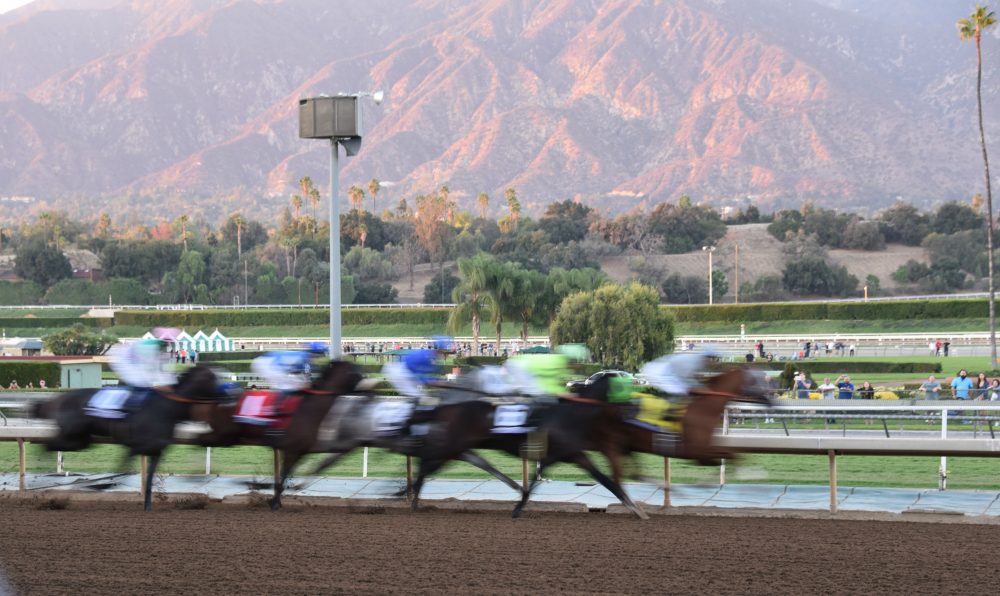By T.D. Thornton c/o Thoroughbred Daily News
Earlier this year, Santa Anita Park quietly rolled out a new policy requiring any licensee wishing to remove their horse’s foal papers from the racing office to sign a waiver of responsibility and provide an explanation about why, where, for how long, and for what purpose the horse and its official registration documentation are leaving the grounds.
This private data-collecting initiative began as a way for track officials to better keep tabs on the local racehorse population. But now that Santa Anita’s sign-out policy for foal paperwork is becoming more widely known, is being lauded within the aftercare community because it could eventually evolve into a best-practice way to track where racehorses go and exactly who is responsible for them upon any exit from a racetrack or licensed training center.
Stacie Clark, an operations consultant for the Thoroughbred Aftercare Alliance (TAA), told TDN in a phone interview that she envisions other North American racetracks will soon follow Santa Anita’s lead, and that racing jurisdictions might someday willingly share this sort of data with aftercare organizations so everyone can get a better handle on the scope and potential costs of caring for Thoroughbreds after their racing days are over.
Clark also explained that this sort of cooperative data collection might eventually pave the way for a more comprehensive national traceability program similar to the one launched by Racing Australia four years ago to track racehorses from foaling through retirement.
“This is great,” Clark said. “We talk about having accountability for first exit out of racing for our horses. And having a form that requires the connections to tell the track where their horses are going for the track’s own inventory reasons makes sense. But the bonus is learning where these horses are actually going. I think it expands awareness, and to have somebody have that ability is a step in the right direction to have all horses accounted for and to know who was the last point of contact. Maybe this will inspire other racetracks to also do this so that we can answer where horses are going once they leave the racing industry. Hopefully it’s to a new home, or a farm for retirement, breeding, or whatever, and not to a bad situation.
“It’s working really well on an extensive basis in Australia, where everyone has to be accountable for all of the horses all of the time,” Clark continued. “This is just sort of a smaller version of that. This initiative is having a side effect that is really positive for accounting for our Thoroughbreds that are leaving the track. The spin-off will be toward better integrity.”
Tim Ritvo, the chief operating officer for The Stronach Group (TSG), which owns Santa Anita, confirmed via phone that this policy would soon be extended to all other TSG tracks (Golden Gate Fields, Gulfstream Park, Laurel Park, Pimlico Race Course and Portland Meadows).
“It’s complementary to aftercare, which is great, because we can keep track of where the horses are going,” Ritvo explained. “But for us, honestly, it’s more of an inventory [control], so we know when a horse is out of the system and why and where it’s going. But if it can help with aftercare, then all the better.”
Madeline Auerbach, a California Horse Racing Board commissioner who is also an owner/breeder, the founder of California Retirement Management Account (CARMA), and a member of the TAA board of directors, told TDN she found out about the policy firsthand several weeks ago when she retired GSW Majestic Heat (Unusual Heat) for breeding purposes and stopped by the Santa Anita racing office to retrieve the mare’s certificate. She was surprised to be asked to sign the tracking form because she had never been asked to do so in all her years in the racing industry.
Auerbach said she got a full explanation from Santa Anita’s vice president of racing, Rick Hammerle, and immediately began spreading the word about the potential for aftercare cooperation that now exists.
“I am so glad I went to get her papers, because this made me aware of the policy, and I can now make our board and other people aware of it too,” Auerbach said. “I hope that this catches on everywhere, because it’s a wonderful help without [aftercare organizations] spending a great deal of money to get the same information that should be available without us spending the money.”
From the view of a regulator, Auerbach was emphatic that Santa Anita is well within its rights in asking for this sort of information.
“These are things that I believe [a racing association] has a right to know, because [the stable area is] their property, and when you have a horse housed on their property…you are supposed to be a part of the show, part of the performance, part of the reason that they are able to generate income from that property,” Auerbach explained. “So they have a right to know what your intentions are with that horse, and they want to keep track of it.”
Auerbach continued: “It’s a very legitimate concern. They have a right to ask, and I am thrilled to see it because one of the biggest problems we’ve had in aftercare is trying to identify the scope and the size of the problem. We’ve had no way really of finding out what happens to horses [that exit the racing population without explanation], and even though [TSG’s initiative] is not a thousand percent accurate, we will have a much better handle when all the tracks adopt this policy of just asking the question, ‘Hey, where’d your horse go?’ We just want to know.”
Asked if she sees Santa Anita’s policy evolving into something like the Australian lifetime traceability model, Auerbach said, “I don’t know that we have to do it exactly the way that they do in Australia, but this would certainly tell us what we need. You can extrapolate the numbers after you’ve done this for awhile. If you have a year or two [of data] under your belt and you start to see the same percentages [as those of horses whose exits from racing were previously unknown], then you can bet that that’s the percentage that’s going to wind up in aftercare. And that will give us a much clearer picture of the scope of the problem, and that’s why it’s so important.”
But will this sort of data be something that TSG is willing to share?
“It could be,” Ritvo said. “I’m not sure that we would share it immediately, because right now we’re just concerned about where horses are going and why they’re leaving. But as we acquire more and more data as things go on,” it would be something TSG would consider, he added.
Auerbach said she was confident that a sharing agreement could be worked out.
“I don’t think TSG or any other legitimate track will have any problem or difficulty in sharing that information publicly,” Auerbach said. “I know it’s proprietary in that they ask for it and that they collect it, but there’s no reason that I can think of that would make it proprietary to the extent that they don’t want to share it, because it helps all of us.
“Look, Santa Anita is a big partner for us with CARMA,” Auerbach continued. “They match the funds that the owners put in. They have a vested interest in what happens to these horses, just like the rest of us do. So they’re a partner, and I can’t see any of TSG tracks not allowing this information to be utilized by the people that are charged with taking care of horses in aftercare. I think they’ll be more than reasonable.”
Clark hinted at similar traceability initiatives that the TAA has in the pipeline.
“There are other things that the TAA is working about inventory that are really in the infant stages, but they’re very positive,” Clark said. “There’s a lot of noise going on within the industry about what is everybody doing and why isn’t everybody doing enough, but sometimes you just can’t talk about what you’re doing until you have the foundation laid down. The board of the TAA is very forward-thinking, and they’re investigating a lot of avenues. So in the future there will be more to talk about, but [the TSG’s tracking program] is going to be really helpful.
“We’re all in this together,” Clark summed up. “I doesn’t matter what team we’re on. We’re not going to have a sport unless we all work together, and that includes having integrity and accountability and a plan.”














